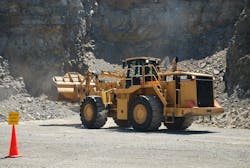Luck Stone Unveils Remote Control Loader
Founded in 1923 and now in its third generation of family ownership, Luck Stone, based in Richmond, Va., is reportedly the largest family-owned-and-operated producer of crushed stone, sand, and gravel in the United States. According to president Bob Grauer, Luck Stone’s long history in this competitive industry is based on delivering quality products with exceptional customer service, along with an open-minded willingness to evolve and innovate.
To that end, the company’s director of innovation, Travis Chewning, recently explained how the company approached what he calls an “age-old industry challenge” by bringing together the right people and the right experience to develop a workable solution.
“As a company we do our best to operate large wheel loaders safely,” says Chewning, “and it’s not uncommon for us to leave behind stone reserves that are deep in the quarry in order to protect our operators. But one of our associates, John Thompson, looked at the situation, and based on his experience some 20 years ago in underground mining, came up with an idea to recover these resources, while keeping operators safe—by removing them from the loader.”
According to Chewning, Thomson, a regional operations manager, was not deterred from the idea simply because no other producers seemed to be pursuing remote-control technology—or because he encountered plenty of people who said the idea wouldn’t work. With Thompson’s guidance, the company interviewed a number of potential technology partners, finally selecting Anchises Equipment, a design and engineering firm with experience in both mining and remote-control technology.
The Anchises Equipment team, says Chewning, quickly developed an approach to integrating a remote-control system into one of Luck Stone’s Cat 988G wheel loaders at work in the company’s Bull Run quarry in Chantilly, Va. On-site, Anchises Equipment engineers worked with Luck Stone’s technical advisor, Clark Church, and plant mechanic, Randy Grimes, to install the needed electronic and hydraulic systems.
The new system has worked so well, says Chewning, that the company’s plan is to “scale up the experiment to prove that the technology can be leveraged to safely increase stone reserves across the organization.”
